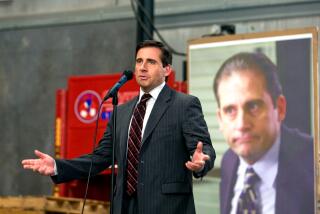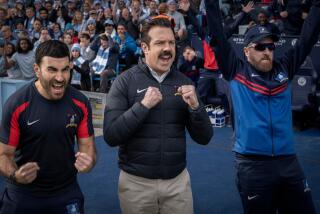The Unsung, Silent Art of Close-Captioning TV Shows
Just before sending off the final tape of the television movie âThe Rise and Fall of the Third Reichâ for network broadcast, supervisors at the National Captioning Institute discovered that one of their editors, apparently unschooled in the basics of Nazi Germany, had typed the words, âHi, Hitlerâ rather than âHeil, Hitlerâ whenever the German crowds saluted their leader.
NCI, the nonprofit corporation that subtitles television programs for the hearing-impaired, caught that mistake, but according to the people who actually close-caption about 4,000 hours of programming each year, that goof illustrates the hundreds of potential pitfalls they confront each day as they transcribe and edit the dialogue and audio portions of Americaâs favorite television shows.
âOnce on âCosby,â â (which is captioned by another company) says Tim Conley, NCIâs production supervisor, âone of the characters mentioned the philosopher Nietzsche, and it went out spelled N-I-C-H-I. Here we deal with stuff like that every day.â
NCI estimates that about 180,000 households, an audience of approximately 700,000 hearing-impaired and their families, own decoding devices (available through the Sears catalogue for about $200) that allow them to read the captions that are transmitted along with the regular video signal.
To keep this small but loyal audience glued to their sets, ABC captions its entire prime-time schedule, and with a variety of network, government and corporate sponsors picking up the $2,500 it costs to caption each hour of programming, a large percentage of NBC, PBS, CBS and Fox programs are captioned as well. NCI also subtitles hundreds of commercials each year and provides live captions for all of ABCâs daily news programs, the Academy Awards telecast and many sporting events.
Most shows are captioned at a reading rate of 150 words a minute. But the dialogue in some programs moves faster than anyone can read, and the editors must trim and change some of the writing to make it comprehensible.
âNo matter what, we always try to retain the style and flair of the showâs dialogue,â says Hope Cornejo, director of NCIâs Hollywood office. âMany in our audience can read lips and that keeps us honest.â
Since they began captioning television shows in 1980, NCI has developed a number of stylistic tricks to help the hearing-impaired audience understand the program. Editors will move the captions around the screen, from side to side and up and down to better designate which character is speaking. They caption song lyrics punctuated with little musical notes and indicate crucial sound effects in brackets.
âItâs quite simple, really,â Conley says.
âSimple,â that is, until the scene in ABCâs new series âthirtysomethingâ in which four characters carry on two separate conversations simultaneously--difficult enough to understand when you can hear it all, certainly impossible to describe intelligibly in captions. And simple until the time âThreeâs Companyâsâ Jack Tripper (John Ritter) decided to pretend he was two different characters--speaking at one moment in his usual voice and the next in a ridiculous Southern accent.
NCIâs editors always find some way to make sense of such confusion--simply choosing what they think are the most important bits of conversation in âthirtysomethingâ and phonetically spelling Ritterâs accented dialogue--but sometimes, Conley concedes, they realize that the audio is the most important part of television.
Conley says a show like âDynasty,â with its slow pacing and frequent dramatic pauses, is the easiest to caption. Adventure shows such as âMcGyver,â with their long action sequences, also used to be routine.
But then âMiami Viceâ began embellishing its action sequences with rock songs, and all the other shows soon followed suit. Now NCIâs editors struggle to make out, and sometimes just plain make up, the lyrics to the songs.
The newer breed of television shows such as âL.A. Lawâ and âSt. Elsewhereâ are even worse. Many scenes in âSt. Elsewhere,â for example, are filled with as many as 10 different characters and all kinds of extraneous but vital dialogue and sound effects. The technical medical terms, Conley says, also keep his editors running to the dictionary all day long.
But the king of impossible shows to caption, Conley concedes, is âMoonlighting.â
â âMoonlightingâ is murder,â Conley says. âThe show depends on those rapid-fire, back-and-forth quips, and we can only get about half of them in. So we just try to give our audience a sense of how fast and furious the dialogue is.â
It takes about 25 hours to caption a one-hour show, and by the end of an episode of âMoonlighting,â the editors at NCI are often ready to yank out their hair. But remembering the end result of what they are doing, Conley says, keeps most of them coming back to work the next day.
âWe captioned a âFrosty the Snowmanâ animated special,â Conley recalls. âAnd we got a letter from a 40-year-old deaf woman who said she had never been able to watch cartoons or puppet shows because she wasnât able to read the lips of the puppets. But this show was so beautiful, she said, that she wept through the entire thing. For me, that makes it worth it.â
More to Read
The complete guide to home viewing
Get Screen Gab for everything about the TV shows and streaming movies everyoneâs talking about.
You may occasionally receive promotional content from the Los Angeles Times.






